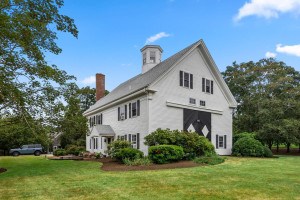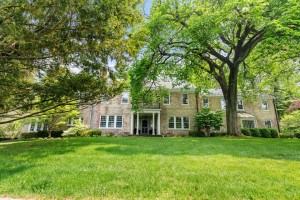Why Is Boston So Ugly?
It’s not like our developers don’t know what great design looks like. Ron Druker should be a shining example of a visionary who’s transforming the way the city looks. He was on the faculty of Harvard’s Graduate School of Design in the ’70s and ’80s. He proudly brings internationally recognized architects to lecture here, including giants of the field like Thom Mayne. On the Cape, for himself, he’s commissioned two artfully modern homes—simmering with sex appeal—from the Boston firm Schwartz/ Silver. But when it comes to his developments in Boston, his prize-winning architects are nowhere to be found. Instead, Druker has left a dreary array of serviceable buildings, including the revamped Colonnade Hotel on Huntington Avenue and Atelier 505, that boxy residential monolith on Tremont Street. He’s been sitting on the hacked-up shell of the Shreve, Crump & Low building at the corner of Arlington and Boylston—once the proud block anchoring the southwest corner of the Public Garden. On the ground floor, where the famed jewelry store used to be, it’s now a ghost town. Across Arlington Street, luxury purveyor Hermès eyes its abandoned neighbor with trepidation.
And Druker is hardly alone. As a class, Boston’s developers act as if they care passionately about…well, the bottom line more than the skyline. When a Boston developer considers himself a patron of the arts, he gives money to the local art museum, rather than contribute a masterpiece of a building. These are guys—and they are almost entirely guys—who don’t seem to understand city-building. And we have to live with their crap.
Meredith Management’s John Rosenthal, a second-generation developer, originally hired a remarkable architect, Carlos Zapata (of Chicago’s Soldier Field), to design a 1.3 million-square-foot Fenway Center project going up along Beacon Street and over the turnpike in the shadow of Fenway Park. Then came the compromise. In the interest of getting financing, he says, he ditched Zapata for the miserable Cambridge-based Architectural Team, known for the most stomach-churning kind of suburban “town-like” architecture. If you want to know what it looks like when a bank designs a building, check out the latest renderings.
After years of letting banks run the show, our muscles have atrophied. We don’t realize the power we could wield. We are busy building the fabric of our lives, and the fabric of our lives has turned out to be 100-thread-count polyester. So who’s supposed to be monitoring architecture around here, anyway?
The Boston Redevelopment Authority is a single agency that’s supposed to drive development while also regulating it; often, this has amounted to the fox watching the hen house, though its new director, Brian Golden, has pressed for more transparency in the approval process. With the mayor calling for better design, you might think Golden would be the person to implement Walsh’s will: Many people fantasize about the BRA strong-arming developers into giving a damn. But as city planner Kairos Shen says, “You don’t want design coming out of the ninth floor of City Hall.”
Instead, the city agency nominally tasked with approving the designs of major city projects is called the Boston Civic Design Commission (it goes by the rock ’n’ roll acronym BCDC), and this winter, Golden and BRA senior architect David Carlson went to meet with its members to learn what could be done to change the culture. The BCDC consists of 11 mayoral appointees, but they lack statutory authority. All of the current members are holdovers from the previous administration (there are no term limits), and many have served for more than a decade. It’s a chummy cabal made up of strong designers with good intentions—such as William Rawn, the architect behind the W Boston—but rather than judge a building’s overall design merit, they tiptoe around issues of taste and beauty, focusing instead on the more-practical issues of urbanism—how the building meets the ground, and what kinds of shadows it casts. The BRA doesn’t want the BCDC slowing down progress.
What’s worse, conflicts of interest on the BCDC are inevitable: The board includes a real estate lawyer from Goulston & Storrs (a firm whose client list is a who’s who of the city’s biggest developers), plus the principals of big firms that are doing the bulk of the design work here. When large projects are up for review, several such BCDC members often must recuse themselves—leaving the board operating without a full deck. It’s not hard to see why we keep ending up with uninspiring façades: The entire design-review process is a mere dalliance.
Full disclosure: I’m very fond of many of the individuals on the BCDC. Like everyone involved in this mess, they mean well. And in meeting with Golden, members of the BCDC complained to the BRA that they needed more time to consider the large, complex buildings they’d been asked to scrutinize. Instead of reviewing fully designed buildings a few weeks before they got the BRA’s green light, the board wanted to look at projects much earlier in the design process. Which sounds reasonable—a volunteer committee can’t rescue an architectural fail in a day. If you want good architecture, quality design (and oversight) has to be on the agenda from the start.
It’s just such a nice group of professionals, Shen says in their defense. They work very well together. In my opinion: to accomplish little.
Shen himself may be part of the problem. He’s the one guy who’s been monitoring architecture from the start, and the results speak for themselves. When I asked him what he thought about the deeply depressing design of 30 Dalton Street, he asked me if I was aware that the façade curved. Yes, it does have a slight curve to it. But a nearly imperceptible curve on a major building in Boston’s skyline is not going to save it from its Walmart pedigree. Later, the BRA sent me a follow-up email reminding me that the building had been approved under the Menino administration. Which is true, but Shen was the BRA’s chief planner then, too.
There is an opportunity, right now, for Boston to prove it’s taking design seriously: at 115 Federal Street at Winthrop Square. The city-owned garage on the site is up for grabs—one lucky group will get to build a 700-plus-foot tower in its place. But that group won’t be chosen on the basis of its design prowess. In fact, in its initial request for information, the BRA didn’t ask for architectural proposals at all. Teams didn’t even need to include an architect in their submissions. Instead, the privilege to transform Boston’s skyline is being treated much like a bid for the city’s trash-hauling contract. In the first round, anyway.
In some ways, the battle has already been lost. The original plan for the site, developed almost nine years ago, was a skinny, 1,000-foot spire designed by architectural god Renzo Piano. Then the FAA intervened, chopping 300 feet off Piano’s plan. In its place? A fat box, Boston’s signature architectural move. Piano walked.
Over the phone, Golden and Shen fret about the tower’s proportions. But wait—as planners, they could mandate setbacks to force a skinny tower out of the site. When you have a big plot of land and you want thin, make sure the new building’s height complements its width. Otherwise, you end up with a refrigerator box.
Planning could have prevented the Seaport’s stubby, faceless towers, too. The Big Dig’s traffic engineers created a mega-block layout that the city’s planners then failed to break down into smaller parcels. Big blocks and big lots—combined with a serious height restriction courtesy of the FAA—conspired to give us the worst American urban waterfront development in a generation. Which is emblematic of what happens here over and over and over. You’d think that architects, forced to work with these squat boxes, would have evolved into the most sophisticated façade designers in the world, to compensate in style for what we lack in proportions. Instead, we wrap our stubbies in glue, glass, and off-the-shelf panels.
The Seaport disaster also reveals our lack of overall vision: Real planners don’t put their office parks on the waterfront. That’s where people want to live—above the marinas, so they can sip their lattes while gazing out across the harbor at the sailboats and yachts. The best cities herd their workaday office buildings into the hinterlands, with good access via public transportation. Paris has its own office park, La Défense. Yes, it’s miserable, but it’s not blocking anyone’s views of Notre Dame. What does it say about us that our office park was whipped up with workmanlike gusto and plopped down on prime Boston Harbor frontage?
If Boston wants world-class architecture, it needs bolder, forward-thinking developers. It also needs to throw out the existing bureaucracy and build oversight into the system. We need big voices here, not polite conversation. It’s time for someone to say no.
Boston deserves a visionary architect who can lead the approval process from the get-go, and empower an independent design board, divorced from the demands of developers and the BRA, to monitor projects as they work through the system. To stimulate vigorous review and prevent nepotism, the new design-review board will need term limits. It should also include architects who don’t work in the city. Finally, we need robust, comprehensive, and innovative planning—in advance of development—to ensure that height and width result in pleasing proportions and energized streetscapes. And then, maybe someday, we won’t have to send our city’s leader to New York to see good design.


